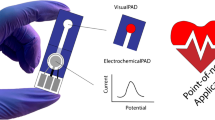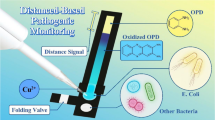Abstract
The oxidation of paper by periodate was investigated and systematically characterized by Fourier-transform infrared (FTIR) spectroscopy, scanning electron microscopy, X-ray diffraction, goniometry, and dynamic mechanical analysis. For the first time, in situ FTIR microscopy analysis was performed, yielding chemical images of carbonyl groups on the cellulose fibers. The enhancement of protein immobilization on oxidized paper was quantified by a colorimetric assay with Ponceau dye, demonstrating that 0.5-h oxidation suffices to functionalize the paper-based devices. The oxidized paper was applied as a sensor for protein quantification in urine, a test able to detect levels of proteinuria and even microalbuminuria. The quantification was based on the capture of proteins through covalent bonds formed with the carbonyl groups on the oxidized paper followed by the staining of the region with Ponceau dye. There is a linear dependency between human serum albumin (HSA) concentration and the length of the stained blot from 0.1 to 3 mg mL−1. This method correlated linearly with a reference method showing a higher sensitivity (0.866 cm mL mg−1) than the latter. The limit of quantification was 0.1 mg mL−1, three times lower than that of the commercial strip.

Paper oxidation with periodate and extensive characterization, including microspectroscopy. The conversion of cellulose hydroxyl groups to aldehyde enhances covalent immobilization of protein on paper for application as analytical device. The oxidized paper determined protein in urine, suitable for proteinuria diagnosis.





Similar content being viewed by others
References
Hu J, Wang S, Wang L, Li F, Pingguan-Murphy B, Lu TJ, Xu F (2014) Advances in paper-based point-of-care diagnostics. Biosens Bioelectron 54:585–597
Nanthasurasak P, Cabot JM, See HH, Guijt RM, Breadmore MC (2017) Electrophoretic separations on paper: past, present, and future - a review. Anal Chim Acta 985:7–23
Foster LS, Gruntfest IJ (1937) Demonstration experiments using universal indicators. J Chem Educ 14:274–276
Martinez AW, Phillips ST, Butte MJ, Whitesides GM (2007) Patterned paper as a platform for inexpensive, low-volume, portable bioassays. Angew Chemie - Int Ed 46:1318–1320
Tang RH, Liu LN, Zhang SF, He XC, Li XJ, Xu F, Ni YH, Li F (2019) A review on advances in methods for modification of paper supports for use in point-of-care testing. Microchim Acta 186:521
Martinez AW, Phillips ST, Whitesides GM, Carrilho E (2010) Diagnostics for the developing world: microfluidic paper-based analytical devices. Anal Chem 82:3–10
Xia Y, Si J, Li Z (2016) Fabrication techniques for microfluidic paper-based analytical devices and their applications for biological testing: a review. Biosens Bioelectron 77:774–789
Li X, Ballerini DR, Shen W (2012) A perspective on paper-based microfluidics: current status and future trends. Biomicrofluidics 6:011301–011301-13
Nery EW, Kubota LT (2013) Sensing approaches on paper-based devices: a review. Anal Bioanal Chem 405:7573–7595
Kong F, Hu YF (2012) Biomolecule immobilization techniques for bioactive paper fabrication. Anal Bioanal Chem 403:7–13
Rusmini F, Zhong Z, Feijin J (2007) Protein Immobilization Strategies for Protein Biochips. Biomacromolecules 8:1775–1789
Yamada K, Shibata H, Suzuki K, Citterio D (2017) Toward practical application of paper-based microfluidics for medical diagnostics: state-of-the-art and challenges. Lab Chip 17:1206–1249
Scida K, Li B, Ellington AD, Crooks RM (2013) DNA detection using origami paper analytical devices. Anal Chem 85:9713–9720
Kim D, Herr AE Protein immobilization techniques for microfluidic assays. Biomicrofluidics 6:041501
Su S, Nutiu R, Filipe CDM, Li R, Pelton R (2007) Adsorption and covalent coupling of ATP-binding DNA Aptamers onto cellulose. Langmuir 23:1300–1302
Wang S, Ge L, Song X, Yan M, Ge S, Yu J, Zeng F (2012) Simple and covalent fabrication of a paper device and its application in sensitive chemiluminescence immunoassay. Analyst 137:3821–3827
Garcia PT, Cardoso TMG, Garcia CD, Carrilho E, Coltro WKT (2014) A handheld stamping process to fabricate microfluidic paper-based analytical devices with chemically modified surface for clinical assays. RSC Adv 4:37637–37644
Barratt J, Topham P (2007) Urine proteomics: the present and future of measuring urinary protein components in disease. CMAJ 177:361–368
Khalid M, Hassan A, Honorato AMB, Crespilho FN, Varela H (2018) Nano-flocks of a bimetallic organic framework for efficient hydrogen evolution electrocatalysis. Chem Commun 54:11048–11051
Macedo LJA, Lima FCDA, Amorim RG, Freitas RO, Yadav A, Iost RM, Balasubramanian K, Crespilho FN (2018) Interplay of non-uniform charge distribution on the electrochemical modification of graphene. Nanoscale 10:15048–15057
Macedo LJA, Crespilho FN (2018) Multiplex infrared spectroscopy imaging for monitoring spatially resolved redox chemistry. Anal Chem 90:1487–1491
Strong EB, Kirschbaum CW, Martinez AW, Martinez NW (2018) Paper miniaturization via periodate oxidation of cellulose. Cellulose 25:3211–3217
McCann L, Benavidez TE, Holtsclaw S, Garcia CD (2017) Addressing the distribution of proteins spotted on μPADs. Analyst 142:3899–3905
Julian BA, Suzuki H, Suzuki Y, Tomino Y, Spavoski G, Novak J (2009) Sources of urinary proteins and their analysis by urinary proteomics for the detection of biomarkers of disease. Proteomics Clin Appl 3:1029–1043
Associated content
The following files are available free of charge. FTIR spectra for all oxidized papers; ANOVA and Tukey’s analysis; variation of color intensity in the protein application spot; variation of the blot length with phosphate buffer pH; correlation of the blot length with increase of BSA concentration; analysis of HSA in urine by Bradford method and comparison between methods (PDF).
Funding
AHI, AH, and FNC gratefully acknowledge the financial support provided by the FAPESP under the grant numbers 2017/05362-9, 2016/25806-6, and 2013/14262-7, respectively. LJMO thanks the financial support by the Coordenação de Aperfeiçoamento de Pessoal de Nível Superior – Brasil (CAPES) – Finance Code 001. TPS gratefully acknowledges financial support from the Conselho Nacional de Desenvolvimento Científico e Tecnológico (CNPq #154064/2016-5). EC is grateful for the INCTBio grants (FAPESP #2014/50867-3 and CNPq #465389/2014-7).
Author information
Authors and Affiliations
Corresponding author
Ethics declarations
All procedures performed in studies involving human participants were in accordance with the ethical standards of the institutional and/or national research committee and with the 1964 Helsinki Declaration and its later amendments or comparable ethical standards.
Conflict of interest
The authors declare that they have no conflict of interests.
Additional information
Publisher’s note
Springer Nature remains neutral with regard to jurisdictional claims in published maps and institutional affiliations.
Electronic supplementary material
ESM1
(DOCX 767 kb)
Rights and permissions
About this article
Cite this article
Imamura, A.H., Segato, T.P., de Oliveira, L.J.M. et al. Monitoring cellulose oxidation for protein immobilization in paper-based low-cost biosensors. Microchim Acta 187, 272 (2020). https://doi.org/10.1007/s00604-020-04250-6
Received:
Accepted:
Published:
DOI: https://doi.org/10.1007/s00604-020-04250-6




